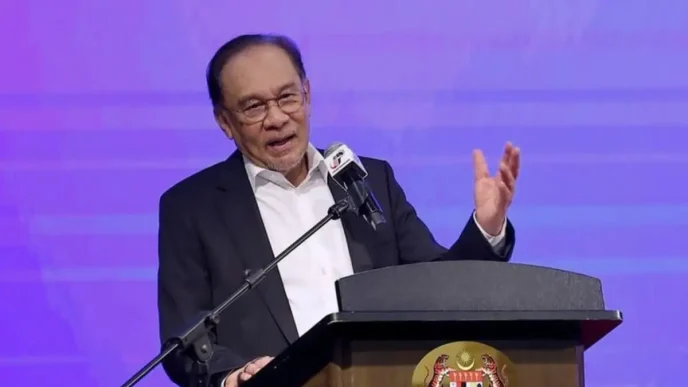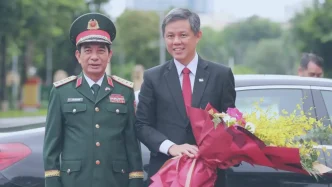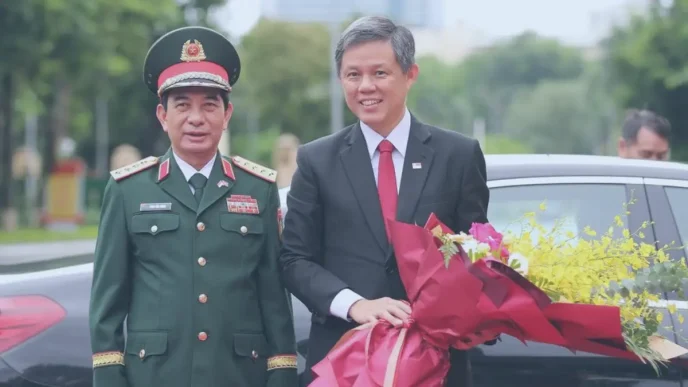In a significant move to enhance transparency and combat integrity issues within its enforcement agencies, Malaysia’s Home Ministry has announced the acquisition of 600 body-worn cameras for Immigration Department officers. The initiative, set to roll out on April 28, 2025, comes as a direct response to concerns raised by Prime Minister Datuk Seri Anwar Ibrahim, who has prioritized professionalism and accountability among the country’s public servants.
A Push for Transparency
Home Minister Datuk Seri Saifuddin Nasution Ismail revealed the plan during his opening speech at the Home Ministry’s Hari Raya Aidilfitri reception on April 24, 2025, in Putrajaya. He emphasized that the acquisition reflects the Prime Minister’s vision to address integrity challenges within the Immigration Department, following reports from the Immigration director-general. “He [Anwar] wants body-worn cameras to be used, and when the director-general informed me, I immediately asked the ministry secretary-general to expedite this” said Saifuddin. He expressed hope that the technology would help resolve integrity cases, stating, “God-willing, we can solve more integrity cases.”
The deployment of body-worn cameras is part of a broader trend in Malaysia to equip enforcement officers with tools to ensure accountability. Earlier in 2025, over 7,000 such cameras were distributed to police officers across 157 district headquarters and 640 stations nationwide. Additionally, the Road Transport Department (JPJ) introduced 100 cameras for its enforcement personnel. The technology has already shown promise, with the Customs Department reporting a decline in violations among officers using body cams, as noted in related coverage by local media.
Prime Minister’s Vision for Professionalism
Saifuddin underscored Anwar’s consistent emphasis on professionalism within enforcement agencies, a theme that has resonated across various government initiatives. During a ministerial awards ceremony for outstanding services on April 23, 2025, the Home Minister relayed Anwar’s appreciation for the Home Ministry staff’s efforts, particularly during the recent official visit of China’s President Xi Jinping. “Anwar said he was deeply humbled, and if we can maintain this momentum, God-willing, the Prime Minister’s wishes of seeing the country being uplifted will be realized” Saifuddin shared.
This focus on integrity aligns with Anwar’s broader reform agenda since taking office, which has often highlighted the need to rebuild public trust in institutions. Analysts suggest that the use of body-worn cameras could serve as a visible deterrent against corruption and abuse of power, particularly at immigration checkpoints, where allegations of bribery and misconduct have periodically surfaced. While no specific incidents were cited in the Home Minister’s remarks, the urgency of the acquisition signals a proactive approach to addressing systemic concerns.
Modernizing Immigration with Autogates
Beyond body-worn cameras, Saifuddin announced another modernization effort aimed at improving efficiency at Malaysia’s airports. Starting in June 2025, manual counters at most airports nationwide will be replaced with autogates to reduce congestion and streamline the travel process. “The autogates will make travel even quicker” the Home Minister noted, highlighting the government’s commitment to leveraging technology for public convenience.
This shift to automation could complement the integrity-focused camera initiative by reducing human interaction at entry and exit points, a factor often linked to petty corruption. Immigration counters have long been a bottleneck for travelers, with complaints about long queues and inconsistent processing times. If implemented effectively, autogates could enhance Malaysia’s reputation as a travel-friendly destination, particularly for tourists and business visitors in a competitive Southeast Asian region.
Regional Context and Comparative Analysis
Malaysia’s adoption of body-worn cameras mirrors a growing trend across Southeast Asia, where governments are increasingly turning to technology to address governance challenges. In Thailand, for instance, police and traffic enforcement officers have trialed similar devices in urban centers like Bangkok, with mixed results. While some reports indicate a reduction in complaints against officers, others highlight logistical issues, such as battery life and data storage, as barriers to consistent use. Malaysia will likely face similar hurdles, including the need to train officers on proper camera operation and ensure footage is handled in compliance with privacy laws.
Moreover, the cost of the initiative raises questions about long-term sustainability. While Saifuddin did not disclose the budget for the 600 cameras, estimates based on regional procurement suggest a price range of 1,000 to 2,000 Malaysian Ringgit (US$210 to US$420) per unit, depending on specifications. This translates to a potential expenditure of 600,000 to 1,200,000 Malaysian Ringgit (US$126,000 to US$252,000) for the initial batch, excluding maintenance and software costs. The Home Ministry will need to balance these expenses against other pressing priorities, such as border security and infrastructure upgrades, to justify the investment to taxpayers.
Public and Expert Reactions
The announcement has sparked varied responses from the public and civil society. On social media platforms like X, some Malaysians welcomed the move as a step toward greater accountability, with users noting past frustrations with immigration processes. Others, however, expressed skepticism about enforcement, questioning whether footage would be accessible to the public or used to protect officers rather than expose wrongdoing. One user posted, “Cameras are good, but who watches the watchers?” reflecting a broader concern about oversight.
Experts in governance and technology have also weighed in. Dr. Aminah Rahman, a public policy analyst at a Kuala Lumpur-based think tank, praised the initiative but cautioned that its success depends on clear guidelines. “Body-worn cameras can deter misconduct, but only if there are robust policies on data usage, storage, and access. Without transparency, they risk becoming a tool for surveillance rather than accountability” she told local media. Her comments underscore the need for the Home Ministry to establish a framework that balances officer accountability with individual privacy rights.
Challenges Ahead
Implementing body-worn cameras is not without challenges. Beyond the financial implications, the Home Ministry must address technical and ethical considerations. For instance, ensuring that footage is securely stored and protected from tampering will be critical to maintaining public trust. Additionally, officers must be trained not only on how to use the devices but also on when to activate them, as inconsistent usage could undermine the initiative’s goals. In other jurisdictions, such as the United States, studies have shown that body cams are most effective when paired with strict activation protocols and independent auditing mechanisms.
Another potential issue is the cultural adaptation within the Immigration Department itself. Resistance from officers accustomed to operating without direct oversight could hinder adoption. The Home Ministry may need to launch awareness campaigns to emphasize the benefits of cameras, not just as a monitoring tool but as a means of protecting officers from false accusations. Saifuddin’s remarks suggest a top-down push for the technology, but grassroots buy-in will be essential for long-term success.
Broader Implications for Malaysia’s Governance
The introduction of body-worn cameras and autogates signals a broader shift in Malaysia’s approach to public administration under Anwar’s leadership. Since assuming office, the Prime Minister has advocated for reforms aimed at modernizing government services and restoring public confidence. This dual focus on technology and integrity could position Malaysia as a regional leader in governance innovation, provided the initiatives are executed with transparency and accountability.
However, the effectiveness of these measures will depend on sustained political will and public engagement. If the body-worn camera program yields tangible results—such as a measurable reduction in complaints or corruption cases—it could pave the way for wider adoption across other government agencies. Conversely, any perception of misuse or inefficacy could erode trust in Anwar’s reform agenda, particularly among a populace weary of unfulfilled promises from past administrations.
As Malaysia embarks on this technological overhaul, the eyes of both citizens and international observers will be on the Home Ministry. The coming months will reveal whether body-worn cameras and autogates are mere symbolic gestures or genuine steps toward a more transparent and efficient governance model. For now, the hope is that these tools will empower both officers and the public to uphold the integrity that Anwar envisions for the nation.














